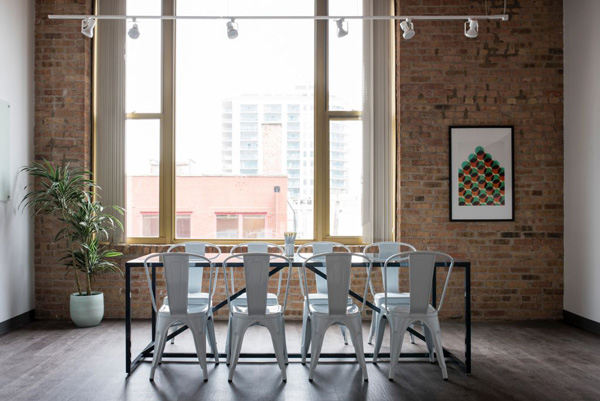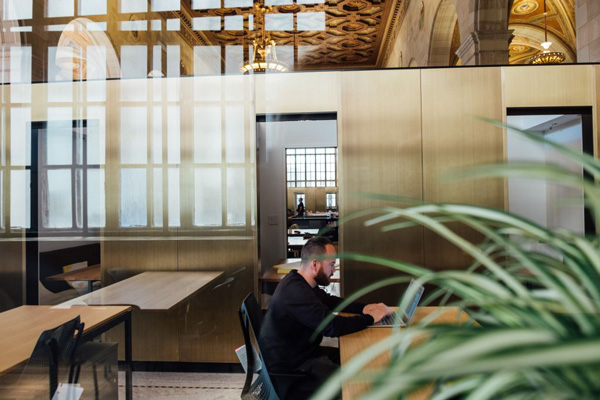
The future is now, especially when it comes to facilities management.
With FMs already employing energy savings, earth-friendly practices, and IoT and robotics to increase efficiency and reduce costs, technological advances to make all of that easier are welcome.
Many of those advances are based on making building occupants healthy, with employee well-being and work/life balance at the forefront.
While you don’t have to actually exchange hugs (there’s an app for that), the trends in FM do have a lot of feel-good about them.
A Healthy Building Leads to Productive Employees
There are three major trends changing the facilities management industry according to facilities management specialist Martin Leitch: sustainability, procurement and thermal comfort.
Sustainability has to do with the built environment, taking into consideration such aspects as ventilation and lighting. It directly impacts the well-being of the building occupants and can lead to increased productivity which in turn can have a positive effect on an organization’s profits.
Responsible procurement has an element of sustainability about it, dealing with finding products and services that are better choices for the environment. This includes everything from cleaning methods and products to water management and recycling practices at a facility. Sustainable procurement also affects the health of a building’s tenants and their performance.
Thermal comfort has to do with the air and temperature of a space. The impact of air movement, air-conditioning and natural ventilation on a building’s occupants is becoming clearer with research. Quite simply, temperature itself dictates performance: “[A]n optimal thermal temperature in an office has transformative potential in terms of well-being and productivity,” Professor Richard de Dear, director of Sydney University’s Indoor Environmental Quality Lab, writes in the same article at The Fifth Estate.
The built environment affects the health and well-being of its occupants so much that a public benefit corporation, the International WELL Building Institute (IWBI) was formed several years ago in line with a Clinton Global Initiative. IWBI administers the WELL Building Standard, a system that measures, certifies and monitors features of buildings that affect the health of those in them.

Working Together For a Common Goal
More practically, perhaps, is the trend ISS Group Chief Commercial Officer Andrew Price has seen of the industry shifting from input-based to outcome-based contracts.
Instead of relying on contracts that depend on “predetermined resources, delivering services within a specific time frame at an agreed price,” Price says the FM industry is moving to a two-party collaboration in which the provider and client have a “mutually vested interest” in the outcome.
In order to secure that outcome, the building’s occupants need to be involved. They need to be asked about how they feel and what things are important to them. Price shows how easy this can be: Just find out how building occupants feel when they arrive in the morning. If it’s anything other than a warm, welcome feeling, pleasant and professional, then the outcome has not been realized.
Obtaining that outcome may well go right back to procuring organic cleaning products or running indoor air quality tests. The point is, though, that the service or product suppliers should have the FM’s big-picture goal in mind: a healthy building.
As Remote Becomes the Norm, Building Change
While remote working has become more mainstream, it’s not just the workplace: More and more students are going to school over the internet, with 83 percent of high schools now offering online classes. And according to the National Center for Education Statistics, back in 2014, almost 30 percent of students in degree-granting postsecondary institutions in the US were enrolled in at least one distance learning course.
This trend has an obvious direct impact on building occupancy at campuses of all educational facilities. While a facility’s student population may stay the same or increase, a significant part of that student body may not physically attend the school. This calls for smaller classrooms and fewer of them. If you continue with how technology is changing the classroom, you see the tendency of teachers and students doing more digital work, with less reliance on paper hand-outs and even whiteboards, in turn leading to less waste, more recycling and time (and money) saved in cleaning and maintenance.
Back at the office, a mobile workforce requires a different design, possibly sharing space. “Office design should reflect this flexibility — furniture that can be relocated or shared among staff, such as hot-desks, can help accommodate the ebb and flow of employees on site at any given time,” Zoe North writes at OfficeSpace.
FMs Have to Manage Specifically Designed Spaces
Along with shared desks and office spaces specifically designed to encourage collaboration, FMs are being challenged to manage and maintain spaces that are non-traditional, built to attract millennial employees, but still incorporate a sense of community among several generations of workers.
Neal Peters at DPM Care writes that the range can be extensive, “from purpose-driven conference rooms to open-seated areas to quiet/'contemplative’ spaces to workstations with modern furniture like sit/stand desks.”
“Companies are adding building features like concierge desks and creating spaces like cafes and workout facilities to drive employee satisfaction and improve work/life balance,” add Peters. “Such spaces, with their unique functionality, create new challenges that many FMs will have to tackle in [the future].”

Real-Time Locating and Location Based Services
Technology has made mobility and real-time data a factor in everyday life, and FMs should be embracing this continued trend.
In facilities housing large numbers of people and supplies, which may include fleets of vehicles, operations are made as seamless as possible with real-time locating systems (RTLS). This tech allows for continuous tracking as it happens, and provides log data for later analysis and tweaking for better efficiencies.
Like RTLS, location-based services (LBS) can be especially useful for the FM responsible for multiple sites. Using LBS, the app provides the user a real-time inventory of supplies and flags those that need reordering.
Technology Continues to Advance
Advances in technology continue to change the facilities maintenance industry.
From using holograms for elevator maintenance to drones for inspection and security work, you can even get microchip implants in building occupants to access doors, electronic devices and equipment.
The FM Forum cites a joint British Land/Worktech Academy report that sees smart buildings communicating with each other properly over the next year as open protocols come on stream. While communication between devices within buildings is a given, the emergence of open protocols means communication between buildings will be easier.
And those microchip implants that the Swedes are wearing? “By 2020 the report predicts that the physical infrastructure of an office building — including what office workers themselves carry or wear — will be part of one complete smart system, generating and autonomously acting upon all kinds of data.”
The effect of all this data gathering is that human performance on every level can be changed. If improved air quality has been proved to greatly increase the cognitive function performance of building occupants, it stands to reason that any improvements in an indoor environment are worthwhile, and the data gathered by a complete smart system can be analyzed to show what needs to be worked on.
Smart buildings also have several other advantages. The data gathered allows us to use space more efficiently, which in turn reduces expenses and environmental impacts. Automation makes facilities easier to run and maintain, too, and with open systems, the entire built environment is adaptable to future technological advances.
In its reports about FM trends, commercial real estate company CBRE agrees that smart buildings will be increasingly common over the next few years, with network integration of everything from lights, sensors and windows to HVAC units, doors and CCTV. The number of individually connected things in use will rise from 4.9 billion in 2015 to 25 billion in 2020.
The impact of this greater integration on facilities management won’t only be better building efficiency but also an increased opportunity to enhance the end-user experience with tailored services. This translates into a happier, healthier and more productive building occupant.
Credits:
Andrew LokeBreather
Crew

